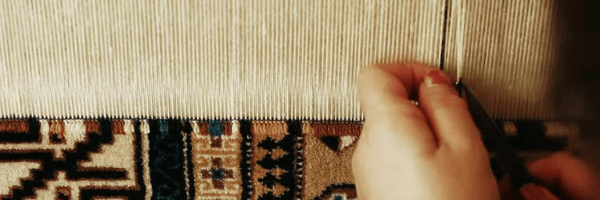
The Berber Feminin domestic weavings are realized by the divers techniques to facilitate their categorization. These techniques are inherited from one generation to another along with its secrets and specificities.The piece shape and its use necessitate some technique.
The weaving techniques are made with a great simplicity and extremely refined. We concluded that the usage of multiple techniques. There are mainly three techniques that are commonly used in the Berber feminin domestic weavings.

- The tapestry-making technique:
This is a very ancient technique. The weaving is handmade produced on a vertical loom, in which the resulting decor occurs by the variation of weft threads.
The woven pieces in tapestry are reversible, the motif is readable in the spot just as backward.
The tapestry techniques are applied on kilims but also on blankets: Farrachiya-s, battaniya-s of kef, and of Gafsa.
- The technique of wrap substitution:
The technique of thread substitution is applied on weavings onward and backward spots produced by a low wrap weaving tool. We can mention the hemel-s executed according to this technique by women of city of Medenine, Tataouine and Sidi-Bouzid.
The production of these decors by wrap substitution requires a very particular attention to the wrapping. The wrap is prepared to serve as the base of the woven decor. Once it is placed on the loom. The weaver woman select colors that have to get at the top of the weaving to compose motifs or to be relegated to the background.
- The technique of weft substitution:
A very common technique used in the decorated domestic weavings: Bakhnoug, Mouchtya-d, etc.
Several weft thread of different colors are inserted successively and then, compacted. The weft threads are not passed through the width of the wrap on one time, but on many times, going back and forth, successif and repetitive till they are carried along the width.
As for the flip side, the composed decor of two colors minimum, is readable and definite, on the backside takes an aspect more tangled. The threads formed at the back to hang-loose. It is at the back of the vertical loom weft. This weaving technique favours compositions of small geometrical repetitive motifs, observed in Mouchtya-s and Ajar-s, etc…. The weavings combine woven stripes and patterns by the technique of substitution of weft which leave us perplexed regarding their function. The utilitarian and the decorative functions are combined well very often.

This excerpt was taken from “Corpus de tissages domestiques féminins Berbèrs”, written by Ben Taher Jamel. Translated by Arij Boudhief.
